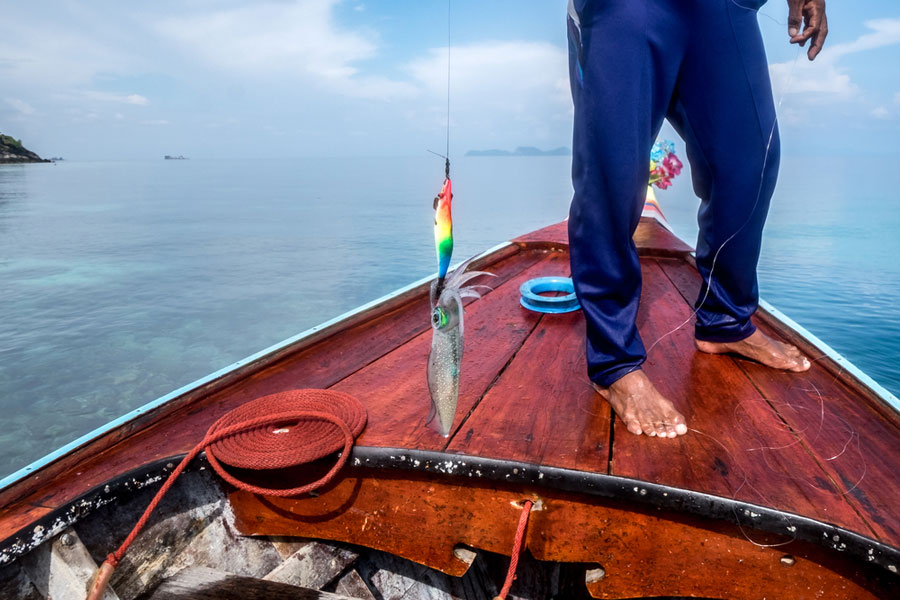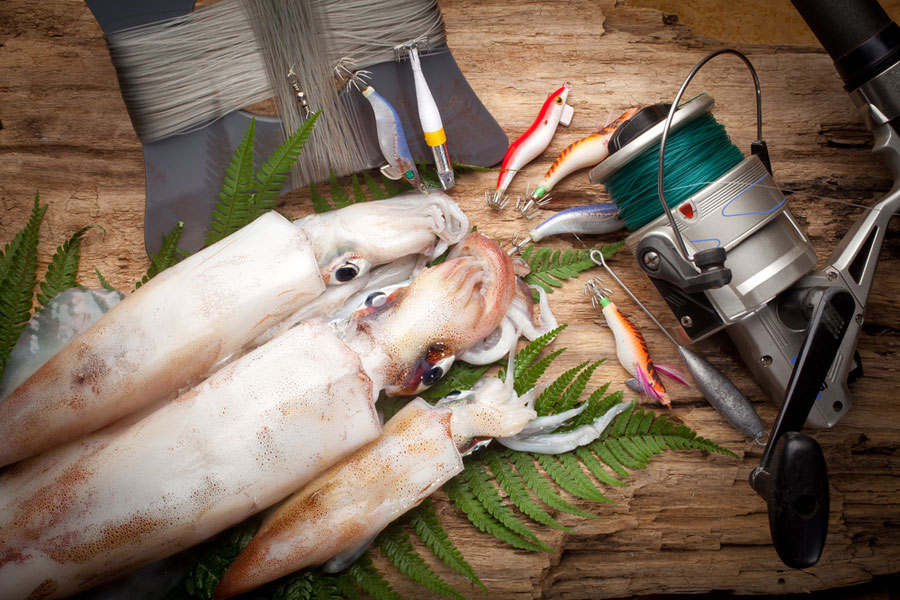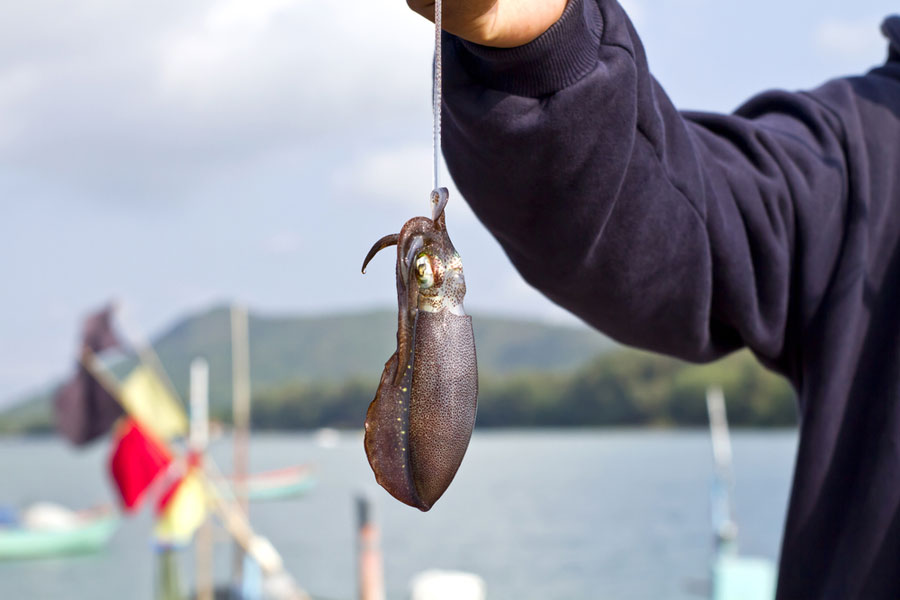Fishing is undoubtedly a fun and rewarding activity as it gives people a chance to interact with nature and reap (literal) rewards. Similar to fishing for salmon and flounder or catching lobster, fishing for squid requires a strong understanding of the species, the right gear and lures, as well as the observance of proper fishing techniques.
Read on if you’re eager to learn how you can catch a fresh batch of squid, which can be turned into a mouthwatering calamari dish!
Step-by-Step Guide to Squid Fishing

Familiarize yourself with your prey
The type of squid you’ll be going for prefer to live in warm and shallow waters, which means they’re usually not very far from shore. Squid spend a great deal of time hiding in rocks, coral, and seaweed to avoid predators, and they will dart out from time to time to catch smaller prey. Consequently, you won’t need a boat to fish for squid. To ensure a successful catch, chose a spot that isn’t too deep and is close to the shore. Make sure the spot is deep enough for your lure to reach the bottom, where the squid are likely to be hiding.
If you are unsure of where exactly you can find squid habitats near you, you can always look it up online or call local governing bodies for more information.
What are the main species of squid?
Squid are members of the cephalopod family and come in many shapes and sizes. Some can be as heavy as 1000lbs and can grow as long as 43 feet. There are about 300 species of squid currently known to man. Here are some of the more significant types:
- Vampire Squid – These squids are characterized by their black coating, which is similar to the capes worn by vampires. Their eyes can either be blue or red.
- Humboldt Squid – These squids are named after the Humboldt currents in the Pacific Ocean, where they were first discovered.
- Japanese Flying Squid – These squids have eight short arms and large triangular fins.
- Giant Squid – These are huge squids that can reach up to 13 meters in length.
- Colossal Squid – These are the mother of all squids and are so large they’ll prey on large fish.
What’s the difference between squid and octopus?
A lot of people confuse squids with octopuses and vice versa. At first glance, that is understandable. After all, both species look fairly similar, possess multiple tentacles and large eyes, and lack shells. That’s where their similarities end, though. Squid have many characteristics that separate them from their octopus cousins. For one, squids swim tail-first rather than head-first. Moreover, squids can have up to three hearts and some species glow in the dark.
Plan when you’re going to go squid fishing
Now that you know more about your multi-tentacled prey, it’s time to figure out your fishing strategy.
Fish at night
Squid fishing is often a nocturnal activity as squid tend to feed at night and are attracted to light. Because of this, fishing after sunset is a good idea.
Fish in the warmer months
Squid prefer warm waters, which means you’re more likely to catch lots of them during spring, summer, or early fall. In any case, it’s always advisable to check out the specifics in your area for water temperatures and squid habitats.
Obtain a proper fishing license
Unless you want to be slapped with a heavy fine and have your gear confiscated, you’ll need to acquire a special stamp or license before you can go squid fishing in your state. This license is required by some fishing stores before you can purchase any of their gear. Rest assured that the money you shell out to get this license will contribute to the maintenance of the marine ecosystem. We wouldn’t want squids to be overfished, now would we?
Gather your fishing gear

One of the more convenient aspects of squid fishing is the fact that you only need two basic pieces of fishing equipment to ensure a successful catch: a jig and a rod.
Jig
A jig is a type of lure that is composed of a lead sinker, a hook, and a very colorful, soft body. Jigs are designed to create a jerky, vertical motion, which attracts the squid. Very little is known about squid psychology, but we do know that squids have excellent eyesight thanks to their prominent eyes. They are also highly intelligent, which means you’re going to need a jig realistic enough to lure these creatures. We recommend getting a handful of jigs in different sizes, colors, and weights to help you figure out which one works best for you.
Rod
Like other types of fishing, you would need a rod to complete the job. Almost any rod would do, given that they’re light and long. This enables you to telegraph even the smallest changes. A light bass rod or spinning rod will do just fine for the job.
There are specialized squid fishing rods for those who plan to make squid fishing a more frequent activity. These lightweight rods are fashioned from graphite and weigh between 3.8 oz and 4.9 oz, and are between 7.5’ to 9’ long. Be very careful with the strain you put on these rods as they tend to be rather fragile. You will also need a drop net to hold your freshly caught squid.
Try out different squid fishing methods

Egging is the basic method for catching squid. This requires some practice but it can be very fun and effective once you get it right. Cast out your jig and let it reach close to the bottom of the seabed. (A specialized squid rod is able to let you know once you’ve reached the bottom.)
Baiting the squid
Once you figure out where the bottom is, make two upward twitching motions with your rod. Drop the jig a bit. This series of actions mimic the motions of prawns and should attract any nearby squids. After a few minutes, it’s time to reel the jig back up to check if you’ve caught anything.
Changing your jig
If no squid takes the bait, you might want to change the jigs. As mentioned above, no one is really sure what the best kinds of jigs are, so it is good to experiment with different types. Switch up your squid fishing lures’ size, weight, and color until you get it right.
Reeling in your squid
Since there are no barbs on the points, it is crucial that you pull constantly and not allow the pressure on the points of the hook to loosen up. It’s also worth noting that pulling too hard or fast might just rip off the squid’s tentacle. It really is all about figuring out the right amount of force to put while reeling it in. Additionally, a drop net comes in handy when the squid is out of the water as it reduces the weight of your catch.
Using the net
Squids, much like octopuses, are known to have a defense mechanism that causes them to squirt black ink that they use to scare off potential predators. A net will help you contain the squid until it runs out of ink. And don’t worry if you get some on your clothes. You’ll be fine as long as you wash it off before it dries completely.
Learn proper storage techniques
Once you have the squid out of the water, put it inside a bucket. This will make sure that any ink left won’t spill over to your boat or the pier. One way to spot if a squid still has ink in it is when it looks fat and puffy.
You’re going to want to kill the squid immediately. Keeping it alive out of its natural habitat will cause unnecessary stress that in turn affects the flavor when cooked. A quick and painless way to put down a squid is to look for a type of tendon in-between the hood and the head. Pinch this part to instantly kill the squid. You’ll know when the job is done when the squid loses color.
The next step is cleaning the squid. Cut the tentacles just under the eyes. Then, discard the head and innards. Skin the hood by ripping the skin along the vertical axis with your fingernail. Once the squid is cleaned, it’s ready for cooking. You may also use the head and innards as bait as most fish go crazy for squid.
Observe safety precautions
You can never be too cautious, especially when dealing with the great outdoors. Cuts, splinters, and hypothermia are just some of the injuries you could sustain in the water. Squids have a bird-like beak that they use to bite potential threats. That’s why it is a top priority to always have a first aid kit with you during your fishing trip.
Basic fishing first aid kits should include scissors, medical tape, bandages, alcohol swabs, hemostats, tweezers, pain relief medicine, and allergy relief medicine. These can all fit inside a small Tupperware container or storage box.
All credit for these awesome tips goes to Leisure Pro. https://www.leisurepro.com/blog/fishing-guides/how-to-catch-squid/





